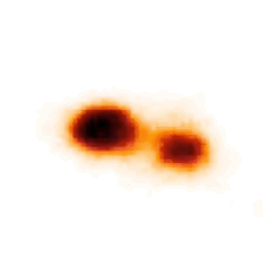The Juno spacecraft has arrived at Jupiter, settling into orbit on July 4th after a trip of just under four years. Juno’s arrival was a flurry of enormous excitement. It’s the first time we’ve actually visited Jupiter since New Horizons blasted past it in 2007 (after a trip of only one year, but then again, New Horizons wasn’t going to stop) and the second Jupiter orbiter, after Galileo’s 1995-2003 mission ended. And something else came out of it: an absolutely gorgeous time-lapse video of Jupiter’s four largest moons orbiting the planet… NASA’s video describes Jupiter as the first place where humanity saw “celestial harmonic motion”, which is true, but unfortunately many places are reporting the Juno time-lapse video as the first time we’ve seen orbital motion.
The video is certainly a striking display of Keplerian orbital motion at work. You can see Jupiter’s four largest moons swinging around the planet over the course of 21 days. It’s very, very cool. But it’s decidedly not the first time we’ve seen it.
The point NASA was making is that Galileo (the man) figured out that the moons were orbiting Jupiter from his own observations and hand-drawn images. It’s a pretty obvious thing once you get access to any kind of telescope or good binoculars. I myself have noticed at college open house nights that the positions of the four major moons (which are definitely not the only moons) change noticeably over periods as short as two hours.
But as for time lapses? How about this time-lapse from the Hubble Space Telescope… you can’t see the full arc of the orbit, but you can see the motion. Or this time lapse from the approach of Voyager 1. (caution: flickery)
If it doesn’t have to be Jupiter, there are some nice animations of a star, called S2, orbiting the black hole at the center of the Galaxy. And also a very nice sequence of the interacting and eclipsing binary system beta Lyrae from the CHARA interferometric array – the image is a bit fuzzy, but these stars are really incredibly close to each other; they orbit once every 12 days, and they’re actually distorted into the shape of eggs:

So yeah, there have been plenty of examples of simple harmonic motion, even as seen by spacecraft.
The Juno mission does have plenty of other special features it can legitimately lay claim to: It’s been put into an orbit over Jupiter’s poles, rather than around its equator – that’s why it could capture a view of Jupiter and its moons from above as seen in the video. It’s also the first spacecraft to use solar panels beyond the asteroid belt, rather than a radiothermal generator. And despite Juno’s predetermined end-of-mission in 2018, Juno should be much more productive than the previous Jupiter orbiter, Galileo. (Galileo’s high-gain antenna malfunctioned, and the probe was stuck transmitting data through its much slower backup systems for its eight year mission…)
So, there are lots of exciting things going on with the Juno mission, even if “first to see harmonic motion” isn’t one of them.